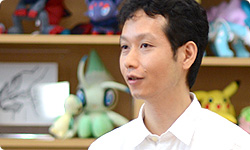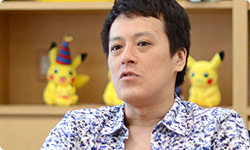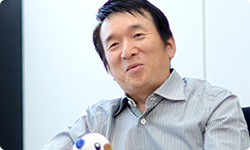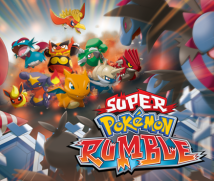2. Thirty Billion Varieties of Pokémon
Ishihara-san, your wife is absorbed in the WiiWare game Pokémon Rumble, so why did you want to make the sequel for the Nintendo 3DS system?
Pokémon Rumble provided its own level of satisfaction, but I kept wondering what we could do next, and I thought I wanted to make a Pokémon Rumble game for playing on the new handheld, the Nintendo 3DS system.
You wanted to release the first Pokémon packaged software for the Nintendo 3DS system.
That’s right! I don’t know why, but for some reason, Ambrella gets a lot of projects that are firsts. (laughs)
(laugh)
Pokémon Dash4 for the Nintendo DS system is an example. 4Pokémon Dash: An action-racing game released simultaneously with the Nintendo DS system in Japan in December 2004.
Even if the hardware isn’t complete yet - it’s still a work in progress, so to speak - we can say, “Do you want to try it?” and as you do, you look like you’re having a ball. (laughs)
Yes. We love doing that! (laughs)
That’s why Nintendo makes so many proposals for new, half-finished hardware to Ambrella. You had Pokémon Rumble as a foundation, and the sequel was going to be for Nintendo 3DS. What did you think at first?
We had actually made a prototype for the Wii console of a successor to Pokémon Rumble, but when we tried to make the same thing for the Nintendo 3DS system, it wouldn’t run the way we wanted it to at first.

Because it was new hardware.
Yes. So we began experimenting. If we had started making a new title for Nintendo 3DS from scratch, we may have decided on an easier approach - not overdoing it and matching what we did to the hardware’s capabilities.
In other words, if you had jumped straight into making a new game for the Nintendo 3DS system, you might have been satisfied with a lower hurdle, but you had gone ahead and made a Wii prototype, so you had already set the bar high.
That’s right. It took a lot of work, working with the programmers and designers, before we could make it look like a Pokémon Rumble game should.
What were you thinking as you began adapting the Wii prototype for a handheld device that can also be played outdoors?
For a handheld, we wanted to make something that you could play spontaneously and just as easily take a break from.
Pokémon Rumble on WiiWare was also originally that kind of game, but this time you wanted to give even more thought to that.
Yes. We adjusted it so you repeat gaming sessions of about 15 minutes, with breaks in-between. Then, once you get into the second and third stages, the game feels like it has grown exponentially and feels new again, so you want to keep playing again and again. That is a big way the game has evolved since Pokémon Rumble on WiiWare.
And rather than making it a compact game because it was for a handheld, we wanted to give it serious volume. Packaged software has to be worthy of sale in stores.
That’s right.
In the WiiWare version, there was only one mode - which was Battle Royale - but we added two this time, for a total of three modes. In Battle Royale , as in the last game, lots of Pokémon battle together until there’s only one left. And we added a Team Battle mode, in which you form teams of three. In this mode, the Pokémon battle automatically apart from the one you control.

So it’s important to choose good Pokémon to be on your side.
That’s right. Another mode we added is Charge Battle . In this mode, you clash with tens of opponent Pokémon, one after the other.
You know how sequel video games tend to gradually become more complicated as you make them?
They tend to get complicated, and that leads to increased difficulty.
Another job of mine this time was repeatedly saying, “Whatever you do, don’t make it a game that’s easy at the start and gradually gets more difficult.”
Oh yes. (laughs)
It got easier to play when we added the Team Battle mode, and when we got to Charge Battle, it got even easier. Thanks to those two modes, we were able to provide gameplay that’s easy to understand.
That’s because you had the goal that you mentioned earlier of making an action game that anyone could play.
That’s right. I think what’s great about Pokémon Rumble games is that anyone can play them. I kept an eye out to make sure that it didn’t become too complicated or difficult when it became packaged software.
It’s easy to say that anyone can play them, but lowering the difficulty too much could make it kind of boring, couldn’t it?
Yes.
How did you find the right balance?
As mentioned earlier, as you play, you pick up lots of moves. In the Pokémon Trading Card Game5, there are some with Special Traits, like Dark Charizard . 5Pokémon Trading Card Game: A collectible card game that represents battles between Pokémon. A wide variety of cards have been sold around the world since the game was first released in 1996.
Yes.
We used those in Super Pokémon Rumble, too. Some of them move fast or make your comrades stronger, so it’s important to gather as many Pokémon with Special Traits as possible.

So as you - in your words - crash into various Pokémon, you look for and gather Pokémon with beneficial Special Traits tacked on.
Yes. (laughs)
About how many Pokémon with such Special Traits are there?
This time, we have added in the new Pokémon from the Pokémon Black Version and Pokémon White Version6 games, so more than 600 Pokémon appear. When it comes to the combinations with various Special Traits, there are about 30 billion types. 6 and : The most recent games in the series, released for the Nintendo DS system in Japan in September 2010.
Thirty billion?!
So each encounter with a Pokémon is unique.
You should treasure it when you run into a really great Pokémon.
For example, you can determine your tactics however you like - “Now that I’ve got this Pokémon, I’ll make this kind of team.”
Like putting together your deck for the trading card game.
Exactly. For example, you go into a Team Battle with three Pokémon, so which kind of team you assemble is important.
Then there are various ways to play.
Yes. For example, a player who doesn’t want to plunge headlong at the opponent can choose teammates with strong offensive abilities so they can concentrate on lending support from the fringes.
Your teammates will automatically attack effectively, so you can rely on them and operate from further back.
Sometimes you can heal your teammates while you hang back somewhere safe so as not to take damage. (laughs)
Yes (laughs), you really can!
